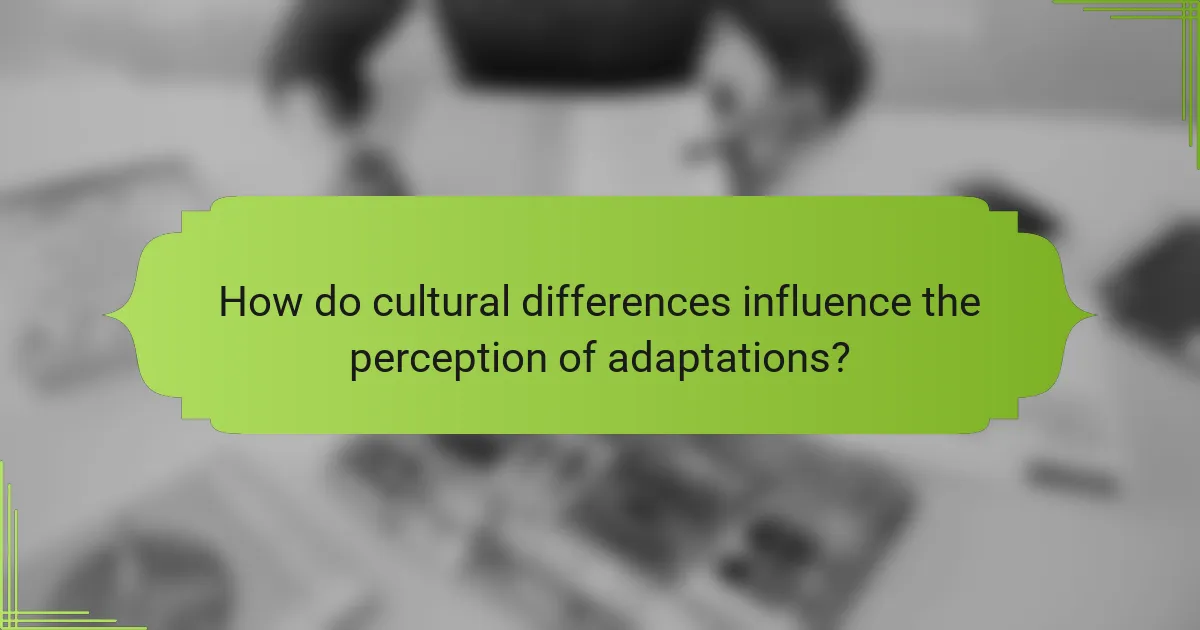Exploring literary adaptations in book clubs enhances understanding of character development and themes. This article discusses key differences between books and films, highlights popular adaptations, and examines cultural influences. It also provides strategies for fostering engaging discussions among members.

What are the key differences between books and their film adaptations?
Books often provide deeper character development and narrative complexity, while film adaptations emphasize visual storytelling and pacing. Key differences include length, with books allowing more detail, and the interpretation of themes, which can vary between mediums. Adaptations may also alter plot points for cinematic impact, leading to unique attributes in the film version. For example, a character’s backstory might be condensed or omitted entirely in a film.
How do narrative techniques differ in literature and cinema?
Narrative techniques in literature and cinema differ primarily in their methods of storytelling. Literature often relies on internal monologue and detailed descriptions, while cinema utilizes visual imagery and sound to convey emotions and themes.
In literature, authors can explore characters’ thoughts deeply, allowing readers to engage with their internal conflicts. This unique attribute of literary narrative creates a rich, immersive experience. In contrast, cinema employs a rare attribute: the ability to show rather than tell, using visuals to evoke feelings instantly.
Moreover, pacing differs significantly. Literature can afford slower pacing to develop plots and characters, while cinema typically requires more concise storytelling due to time constraints. This root attribute of time efficiency in film shapes how narratives are structured and presented.
Understanding these differences enhances discussions in book clubs, especially when analyzing adaptations. Recognizing how narrative techniques transform from page to screen can deepen appreciation for both mediums.
What are common themes that translate well from page to screen?
Common themes that translate well from page to screen include love, conflict, identity, and redemption. These themes resonate universally, making them relatable for audiences. For example, adaptations like “Pride and Prejudice” and “The Great Gatsby” showcase romantic tension and societal struggles effectively. Additionally, themes of adventure and friendship, as seen in “The Lord of the Rings,” enhance viewer engagement through visual storytelling. Overall, successful adaptations often emphasize emotional depth and character development, bridging the gap between literature and film.

Why do book clubs choose to discuss literary adaptations?
Book clubs choose to discuss literary adaptations to explore the differences between books and their film versions. This comparison enhances understanding of themes, character development, and narrative techniques. Members often engage in lively debates about creative choices made in adaptations, fostering deeper insights into both mediums. Additionally, discussing adaptations can attract diverse participants, as films often reach wider audiences than books alone.
What are the benefits of exploring adaptations in a group setting?
Exploring adaptations in a group setting enhances understanding and appreciation of the source material. It fosters diverse perspectives, encourages critical thinking, and promotes deeper emotional connections. Engaging discussions can reveal unique attributes of both books and their film versions, enriching the overall experience. Additionally, sharing insights can lead to a greater enjoyment of literature and cinema.
How do discussions enhance understanding of both mediums?
Discussions enhance understanding by revealing diverse perspectives on both books and their film adaptations. Engaging in dialogue allows participants to analyze themes, character development, and narrative techniques unique to each medium. This comparison fosters a deeper appreciation of storytelling methods, highlighting how adaptations interpret source material. Moreover, discussions often uncover unique attributes of adaptations, such as directorial choices or visual storytelling, which may differ significantly from the original text. As a result, participants can explore the root attributes of both mediums, leading to a richer understanding of their respective artistic merits.

Which popular literary adaptations have sparked significant discussions in book clubs?
Several popular literary adaptations have ignited significant discussions in book clubs, including “The Great Gatsby,” “Pride and Prejudice,” and “The Handmaid’s Tale.” These adaptations often provoke debates on themes, character portrayal, and fidelity to the source material.
“The Great Gatsby,” adapted into multiple films, raises questions about the American Dream and societal values. “Pride and Prejudice” invites discussions on gender roles and social class, while “The Handmaid’s Tale” sparks conversations about dystopian themes and women’s rights.
These adaptations not only enhance understanding of the original texts but also encourage critical thinking and diverse perspectives among readers. They serve as a bridge connecting literature and film, enriching the book club experience.
What adaptations have received critical acclaim and why?
Several literary adaptations have received critical acclaim due to their fidelity to the source material and innovative storytelling. Notable examples include “The Godfather,” praised for its character depth and narrative structure, and “Pride and Prejudice,” recognized for its faithful representation of themes and social commentary. “To Kill a Mockingbird” is celebrated for its powerful performances and emotional impact. These adaptations often enhance the original narratives through visual storytelling and nuanced performances, making them resonate with both audiences and critics.
Which adaptations have faced criticism from readers and viewers?
Several literary adaptations have faced criticism from readers and viewers due to perceived deviations from the source material. Common criticisms include changes to character development, plot alterations, and omissions of key themes. High-profile examples include the film adaptation of “The Hobbit,” criticized for its extended runtime and additional characters, and “The Great Gatsby,” which faced backlash for its modernized elements that some felt undermined the original’s essence. These adaptations often spark discussions in book clubs about fidelity to the source material versus creative interpretation.

How do cultural differences influence the perception of adaptations?
Cultural differences significantly influence how adaptations are perceived across various regions. These variations shape audience expectations and interpretations of both books and their film versions.
For instance, cultural background affects themes emphasized in adaptations. In some cultures, individualism may be highlighted, while collectivism is prioritized in others. This can lead to differing character portrayals and plot focuses.
Moreover, language and idiomatic expressions also play a crucial role. Certain phrases or cultural references may resonate deeply with one audience but appear foreign or lose meaning for another.
Finally, societal norms and values impact acceptance of certain narratives. A story that aligns with local customs may be embraced, while one that challenges them could face resistance. Understanding these factors enriches discussions in book clubs about literary adaptations.
What adaptations resonate more with audiences from different regions?
Adaptations that resonate with audiences vary by region, reflecting cultural values and preferences. For instance, adaptations in Western countries often emphasize individualism and personal conflict, while those in Eastern cultures may focus on community and familial ties. Additionally, local storytelling traditions influence how narratives are shaped, making certain elements more relatable. For example, adaptations of classic literature like “Pride and Prejudice” may highlight social class in Western contexts, whereas adaptations in Asian markets might explore themes of duty and honor. Understanding these regional nuances enhances the appreciation of literary adaptations in book clubs.
Which cultural contexts shape the interpretation of themes in adaptations?
Cultural contexts significantly influence how themes in literary adaptations are interpreted. Different cultures bring unique perspectives that shape audience reception and understanding.
For instance, adaptations of classic literature may resonate differently in societies with varying historical backgrounds. Cultural values and norms can alter the portrayal of characters and themes, leading to diverse interpretations.
Moreover, adaptations may incorporate local elements that reflect contemporary issues, enhancing relevance for specific audiences. This localized approach can shift the thematic focus, emphasizing aspects that align with cultural identities.
Overall, the interplay between cultural contexts and adaptations enriches the narrative, offering viewers a multifaceted experience that reflects both the source material and the cultural lens through which it is viewed.

What are the unique attributes of successful literary adaptations?
Successful literary adaptations often feature strong character development, faithful representation of themes, and visual storytelling that enhances the source material. Unique attributes include the ability to evoke emotions through cinematography and the integration of contemporary cultural references. Additionally, successful adaptations maintain the integrity of the original narrative while making necessary adjustments for pacing and audience engagement. These elements contribute to a compelling viewing experience that resonates with both readers and viewers.
How does fidelity to the source material affect audience reception?
Fidelity to the source material significantly influences audience reception, often shaping their expectations and emotional responses. When adaptations closely align with the original narrative, they tend to satisfy fans, enhancing their viewing experience. Conversely, deviations can lead to disappointment, particularly if key themes or character arcs are altered. This fidelity impacts critical reception, as critics often evaluate adaptations based on their adherence to source material. Ultimately, the balance between innovation and loyalty to the original work can define an adaptation’s success in engaging both new audiences and long-time fans.
What creative liberties can enhance or detract from an adaptation?
Creative liberties can enhance adaptations by adding depth or modern relevance, but they may detract if they stray too far from the source material. Successful adaptations often balance fidelity to the original with innovative storytelling techniques. For example, character development can be expanded, allowing for richer emotional arcs. Conversely, significant plot changes may alienate fans of the book. The unique attributes of the source material should be preserved to maintain its essence. Ultimately, the goal is to create a film that resonates with both new audiences and existing fans.

How can book clubs effectively facilitate discussions on adaptations?
Book clubs can effectively facilitate discussions on adaptations by focusing on key differences and thematic elements. Encourage members to compare character development and plot changes between the book and film. Use guided questions to explore how these adaptations impact the original narrative. Create an open environment for diverse opinions to enhance engagement and understanding.
What strategies can be employed to compare books and films?
To compare books and films effectively, consider analyzing narrative structure, character development, and thematic depth. Focus on how adaptations alter original plots and the impact on audience perception.
Examine differences in pacing and visual storytelling between the two mediums. Discuss the emotional resonance and interpretative choices made by filmmakers.
Encourage discussions on audience expectations and fidelity to source material. This can lead to richer insights and appreciation of both formats.
Utilize comparison charts to visually represent key differences, enhancing understanding of adaptations’ unique attributes and root characteristics.
How can members share diverse perspectives during discussions?
Members can share diverse perspectives during discussions by encouraging open dialogue and active listening. Fostering an environment where everyone feels comfortable expressing their views enhances the richness of conversations. Engaging with different interpretations of literary adaptations allows for a broader understanding of themes and character motivations. Additionally, incorporating various media formats, such as film clips or excerpts, can stimulate discussion and highlight contrasting viewpoints.
What common mistakes should book clubs avoid when discussing adaptations?
Book clubs should avoid focusing solely on the film’s differences from the book. Common mistakes include neglecting character development, overlooking thematic elements, and failing to engage all members in discussion. Additionally, avoiding spoilers can hinder deeper analysis. Prioritize the book’s narrative to enrich conversations.
What are some best practices for choosing adaptations for discussion?
Choosing literary adaptations for discussion involves selecting titles that resonate with the book club’s interests and provoke engaging conversations. Consider these best practices:
1. **Relevance**: Choose adaptations that align with the themes or genres the group enjoys.
2. **Diversity**: Include a mix of classic and contemporary adaptations to broaden perspectives.
3. **Critical Reception**: Select films that have received notable acclaim or sparked debate, enhancing discussion depth.
4. **Cultural Impact**: Consider adaptations that have influenced society or sparked significant conversations.
5. **Member Input**: Encourage suggestions from all members to foster ownership and enthusiasm for the discussions.